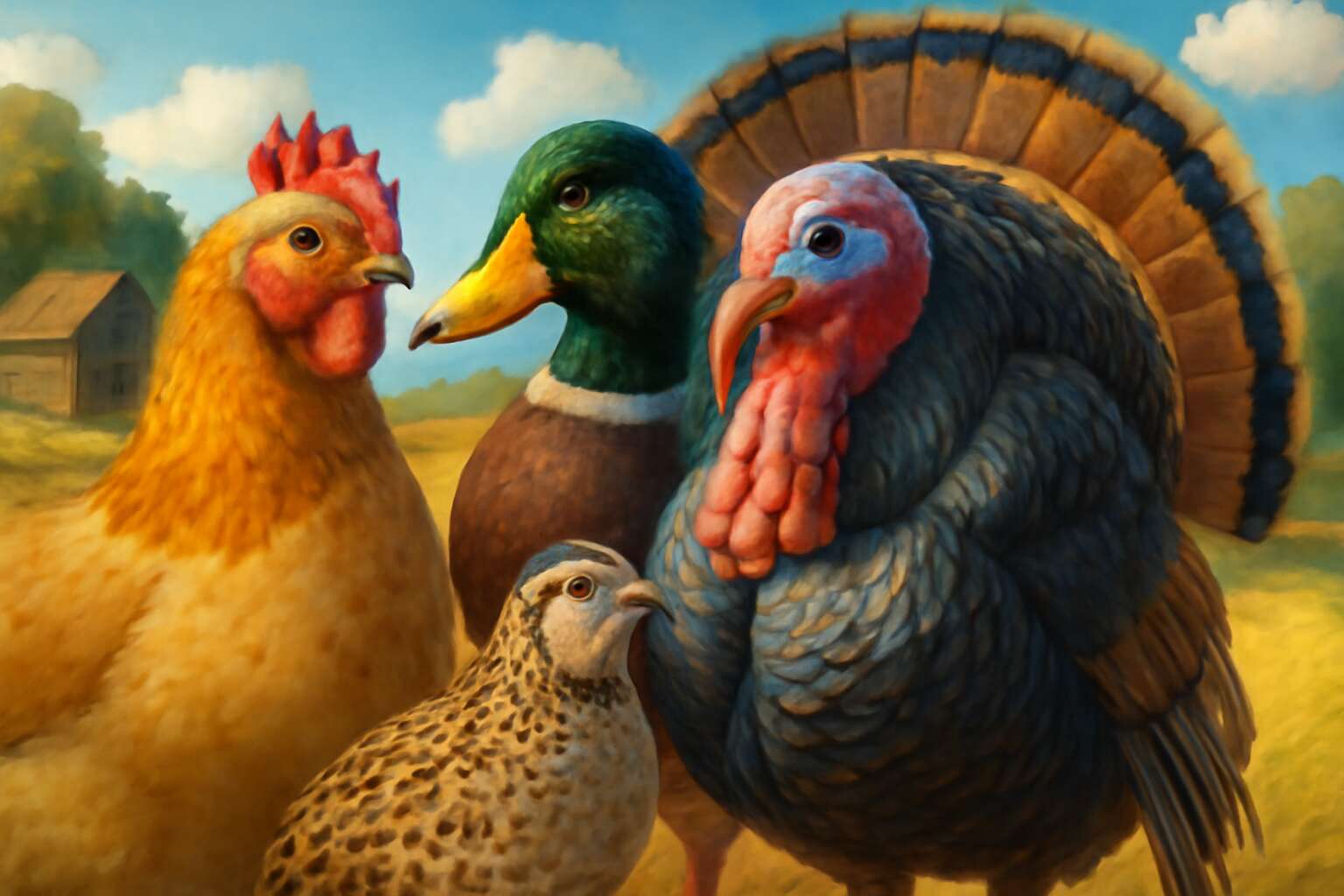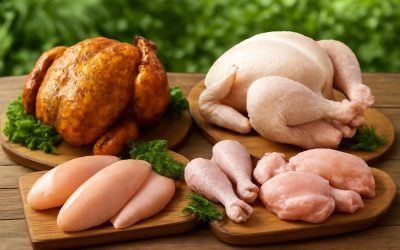Understanding Poultry: An Overview of Key Types
What is Poultry? – Definition and significance of poultry in agriculture and cuisine
Poultry isn’t just a staple in South African kitchens; it’s a vital pillar in global agriculture and cuisine. With over 50 billion chickens raised globally each year, understanding what are the 4 types of poultry becomes essential for farmers, chefs, and enthusiasts alike. These birds serve as an affordable protein source, a cultural delicacy, and an economic engine. Their significance extends beyond the dinner plate, influencing rural livelihoods and local markets.
Within this diverse category, four main types of poultry dominate the scene:
- Chickens, the most common and versatile, are celebrated for their meat and eggs.
- Turkeys, known for their large size and rich flavor, are often reserved for special occasions.
- Ducks, prized for their tender meat and flavorful eggs, thrive in wetlands and rice paddies.
- Geese, with their distinctive appearance and robust meat, are a delicacy in many regions, including South Africa.
Each of these poultry types plays a unique role in culinary traditions and agricultural practices. Their varied characteristics make understanding what are the 4 types of poultry not just fascinating but essential for anyone invested in the world of farming or gastronomy.
Historical Context – Evolution of poultry farming through the ages
Throughout history, poultry farming has evolved alongside human civilization, transforming from simple backyard flocks to a sophisticated industry that sustains millions. In ancient times, domesticated birds like chickens and ducks were primarily valued for their eggs and meat, providing vital nutrition for communities. Over centuries, selective breeding and technological advances have refined these birds, enhancing productivity and flavor. Today, the question of what are the 4 types of poultry remains central to understanding this dynamic sector.
In traditional farming, each poultry type carries its unique story, shaped by environmental conditions and cultural preferences. For instance, turkeys gained prominence in North America but are now cherished worldwide, including in South Africa. Geese, with their robust meat, often symbolize abundance and festivity. Meanwhile, chickens continue to be the backbone of poultry production, appreciated for their adaptability and prolific egg-laying capacities. Recognizing these distinctions helps illuminate the rich tapestry of poultry farming—an industry rooted in history yet ever-evolving to meet modern demands.
Importance of Differentiating Poultry Types – Why knowing the different types matters for farmers and consumers
Understanding poultry isn’t merely a matter of knowing what flaps and clucks—it’s about appreciating the nuanced categories that underpin this vital industry. For farmers and consumers alike, distinguishing between the different types of poultry is akin to understanding the cast of a well-rehearsed play: each has a role, a history, and a purpose that shapes their value on the farm and at the table. Recognizing what are the 4 types of poultry can dramatically influence decisions from breeding practices to culinary choices, ensuring that both productivity and flavor are optimized.
Knowing these distinctions also fosters a deeper respect for the diversity within poultry farming. For instance, some breeds excel in egg production, while others are prized for their meat quality or ornamental appeal. This awareness impacts everything from selecting the right bird for a small-scale backyard operation to scaling up for commercial markets. When you understand the different poultry types, you’re better equipped to make informed choices that enhance sustainability and profitability in South Africa’s evolving agricultural landscape.
Diverse Types of Poultry and Their Characteristics
Broiler Chickens – Traits, growth patterns, and primary uses in meat production
Among the diverse types of poultry, broiler chickens stand out as the backbone of meat production worldwide. Known for their rapid growth and efficient feed conversion, broiler chickens typically reach market weight within just 6 to 8 weeks. Their plump, tender flesh makes them a staple on dinner tables across South Africa, embodying the essence of quick, satisfying meals. These birds are selectively bred to maximize muscle development, especially in the breast and thigh regions, making them highly coveted in the poultry industry.
Broiler chickens exhibit a distinctive growth pattern that emphasizes speed and size. Their robust physique is complemented by a calm temperament, which simplifies handling during processing. This type of poultry is primarily raised in controlled environments to optimize growth rates and ensure high-quality meat production. Knowing what are the 4 types of poultry helps farmers and consumers distinguish the specific characteristics and best uses of each, with broilers playing a crucial role in global food security.
Layer Chickens – Egg production, breed varieties, and housing needs
Among the diverse types of poultry, layer chickens hold a special place in both farmyards and dinner plates across South Africa. These birds are bred specifically for their remarkable ability to produce eggs consistently, making them the backbone of local egg supply. Unlike broilers, which are focused on meat, layers are valued for their prolific egg-laying capacity. Their breeds vary widely, each with unique traits that suit different farming environments and consumer preferences.
Layer chickens typically require a well-ventilated, comfortable housing system that allows for natural behaviors such as nesting and scratching. They can start laying eggs as early as 16 to 20 weeks old, with some breeds capable of producing over 250 eggs annually. To maximize productivity, many farmers choose specialized breeds like Rhode Island Reds, Leghorns, or Australorps. Understanding what are the 4 types of poultry is essential for both farmers and consumers, as each type plays a distinct role in the sustainability and culinary diversity of South Africa’s poultry industry.
Game Birds – Examples like quails, pheasants, and their hunting or ornamental roles
In the intricate mosaic of poultry farming, game birds stand out with their wild elegance and hunting allure. These birds—quails, pheasants, partridges—are not just for the table; they often serve ornamental or sporting purposes. Their unique plumage and elusive nature make them prized among hunters and bird enthusiasts alike. Unlike domesticated chickens, game birds thrive in controlled outdoor environments, where their agility and keen senses are on full display.
Understanding what are the 4 types of poultry reveals the diverse roles each species plays in South Africa’s agricultural landscape. Game birds, for example, are often bred for their beauty and sporting value, but they also contribute to biodiversity and eco-tourism. Their meat, prized for a delicate flavor, adds a gourmet touch to local culinary scenes. These birds symbolize the wild spirit of poultry, reminding us that not all fowl are confined within farmyard fences.
Turkeys – Their role in festive cuisine, breeding details, and characteristics
Among the various factions of poultry, turkeys hold a distinguished place, especially during festive seasons where their grandeur is celebrated on South African tables. Known for their impressive size and robust build, turkeys are not just the centerpiece of holiday feasts but also a vital component of poultry farming. Their breeding is a meticulous affair; they require ample space, specific diet formulations, and a keen eye for selecting traits that enhance meat quality and disease resistance.
What are the 4 types of poultry? Turkeys, with their distinctive waddles and fan-shaped tails, exemplify the diversity within this category. They are primarily raised for their flavorful meat, which boasts a tender texture and rich taste that elevates any celebratory meal. Additionally, they serve in breeding programs aimed at improving stock resilience and production efficiency.
In South Africa, turkey farming often integrates traditional practices with modern innovations, ensuring that these majestic birds continue to thrive both commercially and culturally. Whether as a symbol of bounty or a gourmet delicacy, turkeys embody the robustness and versatility of poultry, reminding us that their role extends far beyond mere sustenance.
Differences and Similarities Among Poultry Types
Physical Features – Size, plumage, and appearance differences
Understanding the physical features that distinguish the four types of poultry is like unraveling a complex tapestry woven with diversity and purpose. Each category, from the plump, robust broiler chicken to the elegant, flight-ready game birds, exhibits unique size, plumage, and appearance traits that reflect their evolutionary journey and functional role. Broiler chickens, for instance, are bred for rapid growth, boasting a compact, muscular frame enveloped in smooth, unremarkable feathers. In contrast, game birds such as pheasants and quails possess slender bodies, intricate plumage patterns, and a nimble build suited for agility and camouflage.
When comparing these varieties, size often serves as a primary differentiator.
- Broilers are notably larger, optimized for meat production.
- Layer chickens tend to be medium-sized with streamlined bodies designed for efficient egg-laying.
- Turkeys, another prominent poultry type, are significantly bigger, with a distinctive rounded breast and wattles that accentuate their grandeur.
Meanwhile, the appearance of game birds emphasizes their role in both hunting and ornamental domains. Despite their differences, similarities emerge—such as the need for specific housing environments and dietary requirements—highlighting that all four types of poultry are intricately connected within agricultural ecosystems, each with their own physical language of survival and productivity. So, what are the 4 types of poultry? They’re a vibrant mosaic, each contributing uniquely to the tapestry of farming and cuisine across South Africa and beyond.
Behavioral Traits – Feeding habits, social behavior, and adaptability
Within the intricate tapestry of poultry, behavioral traits reveal a fascinating spectrum of habits and adaptability. Broiler chickens, bred for rapid growth, tend to be more social but require specific feeding routines to support their muscle development. In contrast, layer chickens are highly social creatures, thriving in flock environments where they can engage in nesting behaviors and exhibit a calm demeanor. Game birds such as quails and pheasants are often more solitary or form small groups, relying heavily on camouflage and agility to evade predators. Their feeding habits are precise, often involving seed and insect diets that mirror their wild ancestors.
Turkeys, with their majestic presence, are known for their adaptability and inquisitive nature, often displaying complex social hierarchies within flocks. Their diet is omnivorous, encompassing grains, insects, and even small reptiles, which reflects their versatility in diverse environments. Understanding what are the 4 types of poultry helps farmers and enthusiasts appreciate these subtle behavioral nuances, which influence housing, feeding, and management practices. It’s a vibrant mosaic—each type with its own social cues, feeding routines, and survival strategies—that enriches the agricultural landscape of South Africa and beyond.
Reproductive Patterns – Egg production, hatching, and breeding cycles
Reproductive patterns among poultry reveal a captivating mosaic of strategies that complement their diverse lifestyles. While layer chickens are prolific egg producers, their breeding cycle is meticulously managed to optimize hatchability, often involving artificial incubation techniques. Conversely, broiler chickens focus primarily on rapid growth, with less emphasis on reproductive output, as their breeding is predominantly controlled through selective genetics rather than natural mating. In the case of game birds such as quails and pheasants, their breeding cycles are more seasonal, mirroring their wild ancestors, with hatching often aligned with environmental cues.
Turkeys, with their impressive size and social complexity, display a reproductive pattern characterized by distinct breeding seasons, during which males display elaborate courtship behaviors. Their hatching process is similarly seasonal, with nesting and incubation tailored to temperate conditions. To understand what are the 4 types of poultry, it helps to appreciate these differences in reproductive cycles, which influence everything from farm management to breeding programs. For instance, the reproductive cycle of poultry is often summarized as:
- Egg-laying frequency and clutch size, varying between breeds and species
- Hatching periods, which typically range from 21 days for chickens to up to 28 days for turkeys
- Breeding seasons, with some species breeding year-round while others are seasonal
- Reproductive behaviors, from solitary nesters like pheasants to social breeders like turkeys
These nuances are the cornerstone of successful poultry management, especially in regions like South Africa, where climate and environment influence breeding success and productivity. Recognizing how these reproductive patterns differ and align among the four poultry types is crucial for farmers, breeders, and enthusiasts alike, ensuring optimal yields and sustainable practices across the poultry spectrum.
Management Needs – Housing, nutrition, and health care considerations
Understanding what are the 4 types of poultry is essential for anyone involved in farming or poultry management in South Africa’s diverse climate. While all poultry share common needs, each type demands tailored housing, nutrition, and health care strategies. For example, broiler chickens thrive on high-protein diets that promote rapid growth, whereas layer chickens require a balanced feed optimized for consistent egg production.
Housing considerations also vary among poultry types. Game birds like quails and pheasants often need secure aviary setups that mimic their natural environment, while turkeys benefit from spacious coops that accommodate their impressive size. Reproductive patterns influence management; seasonal breeders like turkeys and game birds need nesting and incubation conditions aligned with their breeding cycles. Conversely, broilers and layers are typically managed in high-density systems designed for efficiency.
Recognizing these differences and similarities among poultry types ensures sustainable practices and optimal productivity. By appreciating the unique traits of each, farmers can fine-tune their management approach, ensuring healthy birds and bountiful yields across the spectrum of what are the 4 types of poultry.
Choosing the Right Poultry Type for Your Needs
Factors to Consider – Climate, space, and purpose (meat, eggs, ornamental)
Choosing the right poultry type for your needs isn’t a decision to take lightly. Factors like climate, available space, and the primary purpose—whether for meat, eggs, or ornamental value—play a crucial role in this choice. South African farmers, for instance, need to consider whether their environment supports the specific needs of each poultry type, especially in regions with variable weather patterns.
For example, some poultry breeds thrive in warmer climates, while others require cooler conditions. Space restrictions also matter; if you have limited land, smaller or more adaptable poultry types such as game birds or certain layers might be ideal. Additionally, understanding the purpose—whether you’re raising poultry for meat, eggs, or ornamental displays—guides you toward the most suitable breed.
In essence, knowing what are the 4 types of poultry and matching them with your unique circumstances ensures a successful and sustainable poultry farming venture.
Profitability and Market Demand – Economic considerations and trend insights
Economic viability is often the deciding factor for poultry farmers in South Africa. Understanding what are the 4 types of poultry isn’t just about classification; it’s about aligning your farming operation with market demand and profitability. The poultry industry is dynamic, with trends constantly shifting based on consumer preferences and global food security concerns. For instance, broiler chickens continue to dominate meat markets due to their rapid growth and high yield, while layer chickens remain essential for consistent egg production.
Market insights reveal that diversifying your poultry types can open new revenue streams. Game birds, like quails and pheasants, cater to niche markets such as hunting or ornamental displays, often fetching premium prices. Meanwhile, turkey farming, especially around festive seasons, can be highly profitable if managed correctly. Recognizing the unique economic contributions of each poultry type ensures a sustainable venture that adapts to fluctuating trends and consumer needs.
Sustainable Farming Practices – Balancing environmental impact with productivity
Choosing the right poultry type for your farm is a delicate dance between sustainability and productivity, especially in South Africa’s diverse climate. While it’s tempting to focus solely on profit, integrating sustainable farming practices ensures your venture remains viable long-term. Balancing environmental impact with efficient resource use can set you apart in a competitive market.
For instance, broiler chickens are renowned for their rapid growth and high yield, making them a popular choice for meat production. However, if your goal is consistent egg supply, layer chickens—bred specifically for prolific egg-laying—are indispensable. Diversifying your poultry operations can also include game birds like quails and pheasants, which cater to niche markets and often command premium prices.
- Assess your climate and available space, as different poultry types have varying needs.
- Consider market demand—what are the 4 types of poultry that will best satisfy your local consumers?
- Reflect on your farm’s sustainability goals—how can you minimize environmental impact while maximizing output?
Striking this balance is not merely about choosing the most profitable poultry but aligning your farm’s ecological footprint with market trends. In South Africa’s dynamic agricultural landscape, understanding what are the 4 types of poultry is key to crafting a resilient, sustainable enterprise that can adapt to shifting consumer preferences and global food security concerns.
Legal and Ethical Aspects – Regulations, animal welfare, and certification
When selecting the ideal poultry for your farm, understanding the legal and ethical landscape is essential. South African farmers must navigate a range of regulations designed to protect animal welfare while ensuring sustainable practices. Compliance with local standards not only safeguards your operation but also enhances your reputation among conscious consumers. Ensuring that your poultry is sourced from certified breeders or producers can help you meet these standards and demonstrate your commitment to responsible farming.
Animal welfare is at the heart of ethical poultry farming. Proper housing, nutrition, and handling practices are crucial to maintain healthy, stress-free birds. For those wondering what are the 4 types of poultry, it’s helpful to remember that each has specific management requirements, which must align with legal guidelines and ethical considerations. This balance fosters a resilient farm that respects both the environment and animal well-being.
In South Africa, certification schemes such as the South African Poultry Certification Scheme (SAPCS) can provide assurance that your poultry operations meet high standards. Incorporating these certifications can open doors to premium markets and support sustainable farming goals. Remember, adhering to regulations and prioritizing ethical treatment of poultry creates a foundation of trust that benefits your farm’s long-term success.




0 Comments